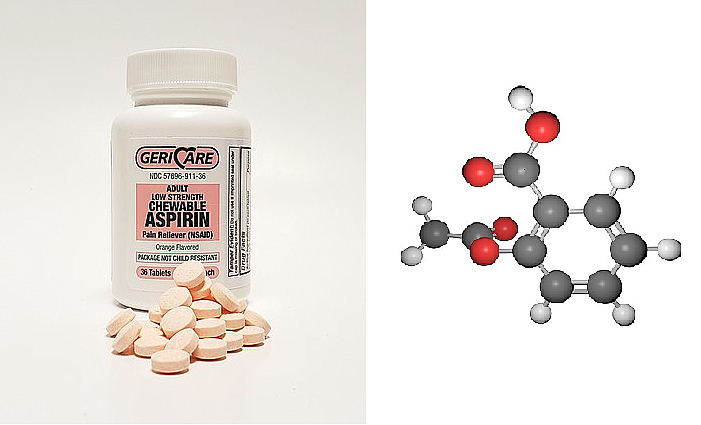UPDATE: Aspirin for Preventing Heart Attacks in Older Adults
July 16, 2024 at 6:20 p.m.
It may be time to rethink your aspirin intake. A survey representing about 150 million adults suggests that aspirin use for primary prevention of cardiovascular disease (CVD) remains prevalent among older adults, contrary to recommendations from the American College of Cardiology and the American Heart Association. The findings, which are published in Annals of Internal Medicine, highlight the urgent need for physicians to inquire about aspirin use and discuss the benefits and risks with older patients.
“Taking aspirin when the risk exceeds the benefit is what we want to avoid. And the risk with taking aspirin is a major GI bleed. Aspirin can cause ulcers in your stomach, and bleeding from these can be life threatening. There is also the risk of bleeding in the brain (hemorrhagic stroke), which increases with aspirin use. There are no data to suggest that coated aspirin will reduce the risk of GI bleeding,” said Dr. Martha Gulati, who is the director of Preventive Cardiology in the Smidt Heart Institute at Cedars-Sinai in Los Angeles, California.
Researchers from Cleveland Clinic studied data from the National Health Interview Survey Sample Adult component (2012–2019 and 2021) to analyze the prevalence of aspirin use for CVD prevention. Participants aged 40 years and older were asked to report aspirin use and were stratified by age group and CVD status based on self-reported history of stroke, myocardial infarction, coronary artery disease, or angina.
The data showed that aspirin use declined from 2018 to 2019 after new evidence prompted the American College of Cardiology and the American Heart Association to recommend against aspirin therapy for primary prevention in older adults. Still, even after this decline, nearly a third of adults aged 60 or older without CVD were still using aspirin in 2021, and nearly 1 in 20 were using it without medical advice.
“Patients get confused when data change. This is the hardest part of medicine. Sometimes we have been doing things in practice that either were based on small amounts of research or observational data. Then we do trials, or even redo trials in a contemporary population and find a different answer than expected. That really can confuse the lay public,” said Dr. Gulati.
Overall, 25.6 million adults reported aspirin use in the U.S, with 18.5 million adults aged 60 years and older using aspirin in 2021. “There is an education gap. Health literacy is lacking because we generally don’t teach this when people are in school. So, we don’t equip people to be empowered to direct their health,” said Dr. Gulati. “Additionally, once someone is on a medication, it often never gets stopped. So, it isn’t just the patient’s literacy, but clinical inertia by clinicians themselves.”
In a separate study, researchers found that more than half of people age 50 to 80 taking aspirin don’t have CVD, and this means low preventive benefit and bleeding risks One in four older adults take aspirin at least three times a week, mostly in hopes of preventing heart attacks and strokes. In all, 57% of people aged 50 to 80 who said they take aspirin regularly also said they don’t have a history of CVD.
National guidelines have changed in recent years for using aspirin for prevention because of new knowledge about who actually gets the most benefit from its ability to reduce the risk of blood clots, and who faces a risk of bleeding. Now, guidelines mostly focus on aspirin use in those who already have CVD, including those who have survived a heart attack or stroke, and those who face a high risk of it because of their personal health and family history.
Whether or not someone has a cardiovascular history, aspirin poses a bleeding risk that increases with age. That has led to guidelines that advise against routine aspirin use after age 70, or suggest that it may be reasonable to consider stopping around age 75 in those without CVD.
The American College of Cardiology and American Heart Association say that daily low dose aspirin use might be considered for the prevention of CVD for select adults 40 to 70 of age, who are at increased risk of CVD, but not bleeding. The U.S. Preventive Services Task Force recommends against initiating aspirin for the prevention of CVD in adults 60 years or older.
There are online calculators to help estimate a person’s 10-year risk of cardiovascular disease. For adults over 50 who have already had a heart attack, some types of stroke or other cardiovascular diagnoses, the use of aspirin is still generally recommended unless the person is unable to tolerate it or has an unacceptable bleeding risk. This is called secondary prevention and should be done only under the supervision of a healthcare provider.
“In the world of social media where there is sometimes unvetted advice being released, people don’t know what to do. We, as physicians and national societies, need to do better at reaching patients. CardioSmart.org is an excellent example of a national society (American College of Cardiology) creating information for the general public,” said Dr. Gulati.

John Schieszer is an award-winning national journalist and radio and podcast broadcaster of The Medical Minute. He can be reached at medicalminutes@gmail.com





